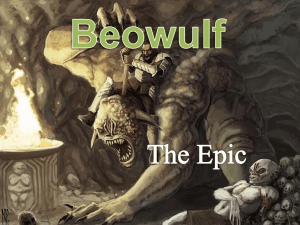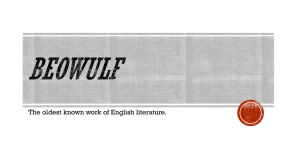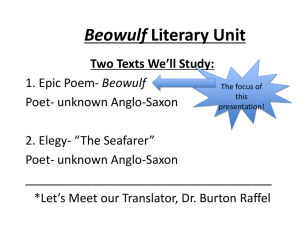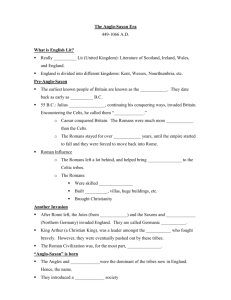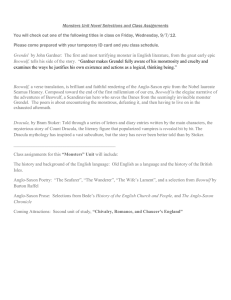The Anglo-Saxons, Beowulf, and Epics
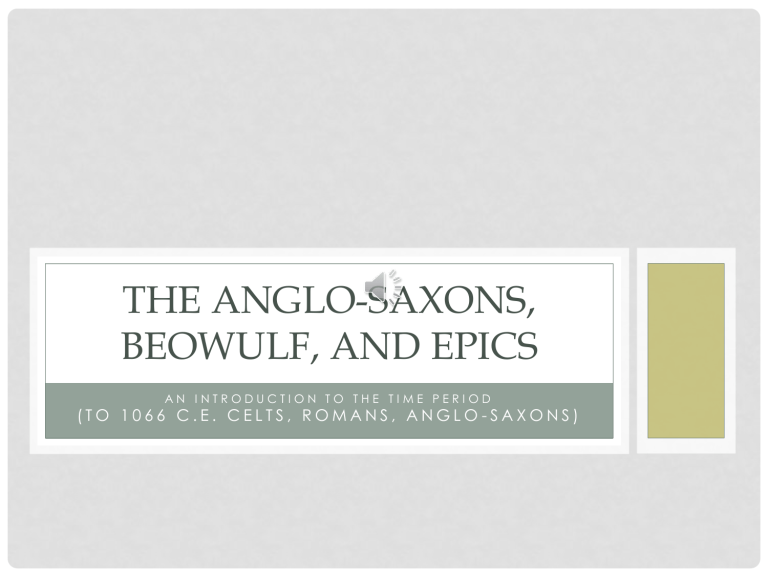
THE ANGLO-SAXONS,
BEOWULF, AND EPICS
A N I N T R O D U C T I O N T O T H E T I M E P E R I O D
( T O 1 0 6 6 C . E . C E L T S , R O M A N S , A N G L O - S A X O N S )
ROMANS (55 BCE-409 CE)
• Julius Caesar invades Britain first (55 BCE)
• The Roman Emperor Claudius defeated the Celts completely (43 CE)
• For the next 350 years, Roman culture (walls, roads, villas, baths, etc.) spread on the island
• When Rome evacuated its troops (409 CE) in order to protect itself from barbarians, the land was left without order or government
BEFORE THE ROMANS, BEFORE THE
NORSEMEN
•
Britain home to several Celtic tribes, including the Brythons
• Celtic religion was a form of animism, in which gods lived in all things (stones, water, trees, etc), headed by priests called druids.
• The Celts were a collection of small tribes without much social structure or organization
ANGLO-SAXON INVASION
A.D. 449 The Anglo-
Saxons push the
Celts into the far west of the country.
ANGLO-SAXON SOCIETY
• clans linked by family ties centered around a strong warrior figure
• people farmed, established local governments, produced fine craftwork-the signs of civilization
• English emerged as a written language (not in a form we can read today)
ANGLO-SAXON RELIGION
• offered no hope of an afterlife to keep people from breaking laws
• people were encouraged to follow laws and to fight valiantly in battle by the idea that good people would be remembered and have stories told about them- this was the Anglo-Saxon immortality
• they valued earthly virtues of bravery, loyalty, generosity, and friendship
• similar to what we call Norse mythology, did not believe the gods “cared for” humans in the way
Christians would
ANGLO-SAXON MORTALITY: THE EPIC
• Anglo-Saxons desired to be remembered through stories, which would be passed down from generation to generation
• bards (called scops) sang around campfires while they strummed a harp, telling of heroic deeds
(usually battles and warriors)
• these scops memorizes popular stories and spread them to various tribes, changing the story as they retold it (always exaggerating more)
• this practice inspired young warriors to imitate the heroes of old (like Beowulf) in an attempt to establish their own story
MEET THE MONKS
• when Christianity became Rome’s official religion
(ca. 400 CE), monks quickly traveled to Britain and built monasteries
• after the Anglo-Saxon invasions (mid-400’s CE), monks began to convert the various tribes
• they used Anglo-Saxon stories (like Beowulf) to help convert listeners, by retelling the story and replacing pagan gods with references to God and Christ
• by 700 CE, Christianity had replaced the pagan religions
300 YEARS
• from 700 – 1066, Anglo-Saxon dominated the landscape, unifying the island
• then, William the Conqueror, seeking his own kingdom, landed (1066 CE) and defeated the
Anglo-Saxon army under King Harold
• William was from France, so French replaced English as the language of the ruling class and the island developed ties with the European continent that last to this day (including a long history of warfare!)
EPIC LITERATURE
T E R MS , C O N C E P TS , AC T I VI T I ES
ALLITERATION
• the repetition of a consonant sound in words that placed closely together
• e.g. the lovely ladies from Louisville left Florida after they landed late at night
• adds a sense of rhythm to the language
• shows creativity, makes the phrase stick in the listener’s mind
ALLUSION
• reference to a person, place, thing, event, or other work of art
• e.g. “You might as well be the Statue of Liberty,”
Sam yelled.
• e.g. The water rushed over John’s head as though he was only a twig caught in the biblical flood
• provides a context or shows further meaning
• signals that a moment in the story is significant or has meaning beyond what is happening
KENNING
• a metaphorical renaming of a person, place, or thing
• e.g. There’s Mr. Thompson’s room, that repository of wit and wisdom
• e.g. Thomas turned and faced the shepherd of demons
• heightens the tension in the story
• provides reader with vivid descriptions to understand the subject
ARCHETYPE
• The original or ideal (“best example”), upon which later versions are based.
• Beowulf is an archetypal epic hero because later heroes followed the same pattern (brave, superhuman abilities, sought glory, etc).
• There are many different archetypes, including:
• the hero (Neo, Odysseus)
• the mentor (Morpheus, Gandalf)
• the seducer (the One Ring, the Ice Queen)
• the trickster (Hermes, Coyote, Aladdin)
EPIC (DEFINITION)
• long poem or story that retells the adventures of an epic hero.
• the centerpiece of an epic is the hero’s journey, during which the hero must overcome monsters, enemies, and other obstacles in order to achieve a goal (usually, the protection of a society/culture)
• an epic is a very specific type of literature, considered to have taken place “in the past” but not “in another age” (e.g. within a few generations)
EPIC (HISTORY OF)
• originated as oral traditions, passed down (and altered many times) until they were recorded
• served as a means to communicate values that were important to a culture, as well as to establish national pride and to provide a role model
• probably began with some true event that became exaggerated as well as combined with other stories during each retelling
• these stories linked a culture together by creating a sense of common history and future
MYTH
• Qualities of a myth:
• emerges from a large cultural group (e.g. Greek, Egyptian, etc)
• explains the workings of the universe/nature or pass along guidelines, morals, advice, wisdom, etc. about how to interact with the gods & with the natural world
• includes intervention by gods, often uses magic
• were considered to have taken place “in another age”, before this particular segment of time (e.g. long before the present)
EPIC VS. MYTH
Epics are not myths:
• longer than most myths
• involve more detail and more description of the hero & the hero’s journey
• focus on the exploits of a human hero (a myth focuses on a god or demi-god)
• epics were said to have taken place “in the past”, while myths took place “in another age”
EPIC HERO
1.
overcomes impossible tasks with superhuman abilities
2.
“better” than average human, but still mortal
3.
goes beyond human limitations, discovers/faces what is beyond his society’s understanding
4.
sets out to accomplish a task / defeat an evil / gain a reward
5.
embodies his culture’s most valued traits
6.
is slain or accepts death gracefully at the end; demonstrates the proper way to die, provides comfort for those who know they will die one day
7.
central figure in an epic story or poem
SYMBOLISM
• symbol: a person/place/thing/event that is itself and representative of some abstract idea
• when we see something that represents an idea, we say it is symbolic of __________
• an object may be symbolic of one idea at one time and symbolic of something else at another time
• symbolism is relative to the reader
• you must provide proof of symbolism (e.g. The flag in the story is symbolic of death because it flies over the graves of each of the victims.)
BEOWULF
C H R I S TI ANI TY VS . P AG AN I S M
A PAGAN TALE BY A CHRISTIAN SCRIBE
• originally Scandinavian (pagan), no link to
Christianity, values very different:
• boasting of exploits (Christ was humble)
• glory-seeking (Christ glorified the Father)
• violence, war (Christ blessed the meek)
• vengeance, destruction (Christ turned the other cheek)
PROPAGANDA
• the monks who settled in Britain were missionaries- they sought to convert the Celts, then the Anglo-Saxons, to
Christianity
• Beowulf, a story to which the Anglo-Saxons could relate, was altered so that the Christian God received the glory
(as if to say to the pagan audience, “See? Our God can make you strong, too.)
• the story’s changes also helped the monks relate popular Biblical stories (Beowulf’s sacrifice for the Geat kingdom could be compared to Christ’s sacrifice for the
Christian kingdom)
• the story relayed important Christian ideas to the audience (Grendel as a descendent of Cain, the idea of
“original sin”)
CHRISTIAN MONSTERS
• Christian scribes had to provide a context for Grendel, because (a) God created everything, (b) but an allgood God would not create an entirely evil monster
• solution: Grendel becomes a descendant of Cain, the first murderer
• pagan monsters tended to be servants of the gods, who acted in accordance with the god’s will
• pagan monsters also served a purpose: guard a treasure, protect an area sacred to a god, hold humans back (and thus becoming like gods)
• Christian monsters were basically evil, without a definite purpose or mission, other than to do evil, cause destruction, create sin, etc.
PAGAN ELEMENTS
• the scribes kept many pagan elements that made
Beowulf so popular, in order to link the audience’s hero
(Beowulf) with the Christian’s hero (Christ):
• the warriors fear a shameful death (such as Grendel killing you while you slept)
• Grendel is more monstrous than human
• mead halls, gold and treasure, and weapons are all listed to add prestige to the kingdom and its king
• warriors boast of their exploits in order to continue their legend
• the partying and drinking were celebratory acts and were considered signs of the king’s generosity
THE FATE OF HEOROT
• the mead hall is alternatively praised and cursed in the story
• it is described in all its majesty, but with the reminder that it would burn to the ground
• in some ways, the monks would have disliked the mead hall as much as Grendel, because it was a place of violence, drunkenness, and noise
• thus, the monks felt no remorse to mention that mead hall would eventually be destroyed by firethis was a fitting end to a place built by a king who was celebrating violence
BEOWULF: THE EPIC HERO
C O MI NG S O O N

